Global Nanotechnology Face Mask Database
R&D and Barrier Technologies for Respiratory Diseases
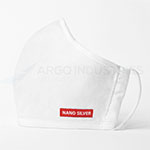 A FFP2 equivalent washable, reusable 3-layer antibacterial mask with a middle layer of silver-coated nanofibers.
A FFP2 equivalent washable, reusable 3-layer antibacterial mask with a middle layer of silver-coated nanofibers.
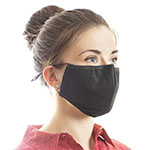 A 5-layer, washable, Type IIR Face mask with a self-disinfecting TiO2 nanoparticle coated surface.
A 5-layer, washable, Type IIR Face mask with a self-disinfecting TiO2 nanoparticle coated surface.
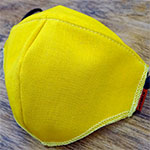 Nomex® Nano Flex is a highly breathable FR material that is highly flame resistant and also delivers superior particle barrier performance.
Nomex® Nano Flex is a highly breathable FR material that is highly flame resistant and also delivers superior particle barrier performance.
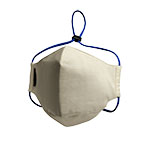 A reusable face mask created with layers of cotton charged with copper oxide and a nanomembrane filter insert.
A reusable face mask created with layers of cotton charged with copper oxide and a nanomembrane filter insert.
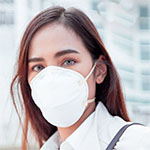 The mask contains a nanofiber layer of polymer PVDF sandwiched between two layers of PET Spunbond.
The mask contains a nanofiber layer of polymer PVDF sandwiched between two layers of PET Spunbond.
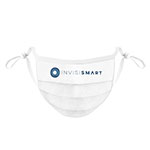 The mask incorporates titanium dioxide nanoparticles for its antimicrobial action.
The mask incorporates titanium dioxide nanoparticles for its antimicrobial action.
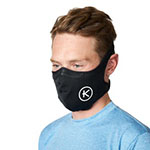 Using a triple sandwich layer?nanofibers?combination, the K-Filters have been designed as a re-usable filter. The nanofibers are made from biocompatible hydrophobic material which is elastic and electrostatic, meaning they are highly breathable and flexible, and will not become wet with water vapour from breathing.
Using a triple sandwich layer?nanofibers?combination, the K-Filters have been designed as a re-usable filter. The nanofibers are made from biocompatible hydrophobic material which is elastic and electrostatic, meaning they are highly breathable and flexible, and will not become wet with water vapour from breathing.
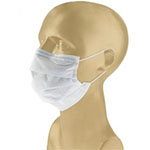 Efficiency of YourMask was tested by Nelson Laboratories in the USA and their measured filtration efficiency is 99.80% for bacteria filtration and 99.86% for filtration of viruses.
Efficiency of YourMask was tested by Nelson Laboratories in the USA and their measured filtration efficiency is 99.80% for bacteria filtration and 99.86% for filtration of viruses.
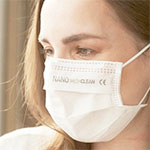 The mask is made of a three-layer filtration medium composed of a supporting textile layer, a nanofiber filter, and a textile protective layer.
The mask is made of a three-layer filtration medium composed of a supporting textile layer, a nanofiber filter, and a textile protective layer.
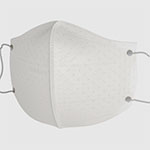 Reusable nanofiber-based drape with nanofibrous membrane BreaSAFE® NnF MBRANE with active silver.
Reusable nanofiber-based drape with nanofibrous membrane BreaSAFE® NnF MBRANE with active silver.
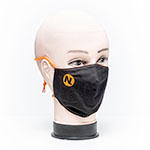 A two-layer cotton textile face masks with a pocket for the possible use of filter inserts. The mask's protective function can be significantly enhanced by using a filter insert made by NANOLOGIX, consisting of nanofibrous filtration materials with a certified viral filtration efficiency of more than 99%.
A two-layer cotton textile face masks with a pocket for the possible use of filter inserts. The mask's protective function can be significantly enhanced by using a filter insert made by NANOLOGIX, consisting of nanofibrous filtration materials with a certified viral filtration efficiency of more than 99%.
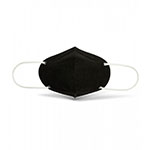 Designer nano face masks are fitted with a nanofiber membrane test proven to capture 97-99.9% of bacteria, viruses, pollen, and other sub-micron particles. The nanofiber membrane also contains Nanosilver particles, which prevent microorganisms from surviving and proliferating in the structure of the mask.
Designer nano face masks are fitted with a nanofiber membrane test proven to capture 97-99.9% of bacteria, viruses, pollen, and other sub-micron particles. The nanofiber membrane also contains Nanosilver particles, which prevent microorganisms from surviving and proliferating in the structure of the mask.
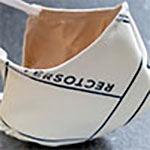 The outer layer has a water repellent finish to make sure that the absorption of humid particles is reduced to a minimum. The middle layer was specifically selected to filter as much particles as possible. The inner layer is a special copper infused Nanostitch® fabric containing certified anti-microbial and anti-bacterial properties called Nanostitch Cuprana.
The outer layer has a water repellent finish to make sure that the absorption of humid particles is reduced to a minimum. The middle layer was specifically selected to filter as much particles as possible. The inner layer is a special copper infused Nanostitch® fabric containing certified anti-microbial and anti-bacterial properties called Nanostitch Cuprana.
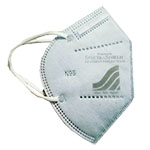 14-Day reusable respirator mask with Fosshield® technology using nanoparticulate silver-copper zeolite antimicrobial agent embedded throughout the fabric of the mask.
14-Day reusable respirator mask with Fosshield® technology using nanoparticulate silver-copper zeolite antimicrobial agent embedded throughout the fabric of the mask.
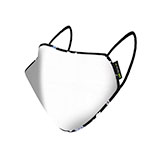 A 3-layer mask with a nanofiber membrane sandwiched between two cloth layers. The nanofiber membrane is tested to filter down to 0.1 micron with a >99% efficacy.
A 3-layer mask with a nanofiber membrane sandwiched between two cloth layers. The nanofiber membrane is tested to filter down to 0.1 micron with a >99% efficacy.
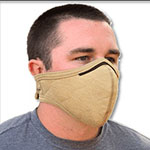 BarriAire™ particulate products combine two layers of proven flame-resistant fabric and a middle layer of ultra-lightweight DuPont™ Nomex&refg; Nano Flex fabric which blocks penetration of 96% to 98.8% of harmful submicron size particulates. BarriAire™ Gold quilted composite fabrics recently achieved Viral Filtration Efficiency (VFE) Rating of 96.8% and Bacterial Filtration Efficiency (BFE) Rating of 97.9%.
BarriAire™ particulate products combine two layers of proven flame-resistant fabric and a middle layer of ultra-lightweight DuPont™ Nomex&refg; Nano Flex fabric which blocks penetration of 96% to 98.8% of harmful submicron size particulates. BarriAire™ Gold quilted composite fabrics recently achieved Viral Filtration Efficiency (VFE) Rating of 96.8% and Bacterial Filtration Efficiency (BFE) Rating of 97.9%.
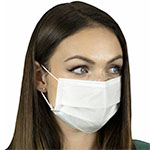 The mask contains a membrane of nanofibers are made of 99.9% polypropylene and 0.1% PVDF (polyvinylidene fluoride) with a base of non-woven fabric.
The mask contains a membrane of nanofibers are made of 99.9% polypropylene and 0.1% PVDF (polyvinylidene fluoride) with a base of non-woven fabric.
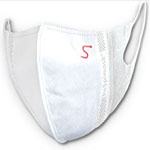 The nanofiber filtration layer in ReSpimask is covered from both sides with nonwoven fabric. It captures 99.9% of allergens, viruses, bacteria, mold, dust, smog, emissions and other dangerous airborne particles.
The nanofiber filtration layer in ReSpimask is covered from both sides with nonwoven fabric. It captures 99.9% of allergens, viruses, bacteria, mold, dust, smog, emissions and other dangerous airborne particles.
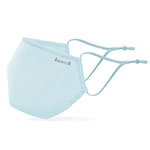 The outer and inner layer of Avevitta Protect 2.0 Mask is permanently ionized and denatures the protective protein coat of the virus, killing the virus. The two middle layers are a polypropylene filter with >99% efficiency and a PFTE nanofiltration membrane with 100-200nm nanopore structure.
The outer and inner layer of Avevitta Protect 2.0 Mask is permanently ionized and denatures the protective protein coat of the virus, killing the virus. The two middle layers are a polypropylene filter with >99% efficiency and a PFTE nanofiltration membrane with 100-200nm nanopore structure.
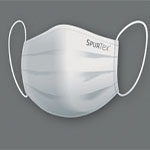 3-layer mask with viscose outer layers and a nanofiber membrane middle layer with capture performance down to 100 nm.
3-layer mask with viscose outer layers and a nanofiber membrane middle layer with capture performance down to 100 nm.
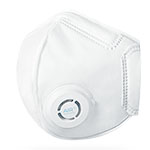 N95 mask with a reusable snap-on micro ventilator. The surface of the mask is coated with anti-microbial technology proven to kill 99.9% of bacteria and viruses. The layer inside the mask filters more than 95% of PM2.5 and harmful particles.
N95 mask with a reusable snap-on micro ventilator. The surface of the mask is coated with anti-microbial technology proven to kill 99.9% of bacteria and viruses. The layer inside the mask filters more than 95% of PM2.5 and harmful particles.
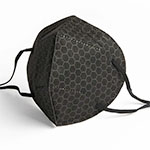 The four-ply arrangement offers users a beneficial level of protection against airborne allergens, pathogens, pollen and dust particles that are larger than 0.3 microns in size, providing a minimum level of filtration of 94%. The mask is enhanced with a unique layer featuring an advanced graphene material, Nanene™.
The four-ply arrangement offers users a beneficial level of protection against airborne allergens, pathogens, pollen and dust particles that are larger than 0.3 microns in size, providing a minimum level of filtration of 94%. The mask is enhanced with a unique layer featuring an advanced graphene material, Nanene™.
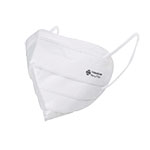 Reusable, washable mask featuring a nanofiltration membrane composed of 200-800nm thick synthetic nanofibers.
Reusable, washable mask featuring a nanofiltration membrane composed of 200-800nm thick synthetic nanofibers.
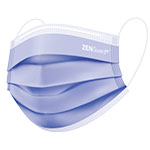 ZenGUARD™ is a hydrophilic, water attracting graphene-silver nanocomposite coating that adsorbs bacteria and virus-laden aerosols and deactivates them.
ZenGUARD™ is a hydrophilic, water attracting graphene-silver nanocomposite coating that adsorbs bacteria and virus-laden aerosols and deactivates them.
 This research studies the synthesis of nanoporous membranes comprising carbon dots (C-dots) and poly(vinylidene fluoride) (PVDF), and demonstrates their potential use for recyclable, self-sterilized facemasks.
This research studies the synthesis of nanoporous membranes comprising carbon dots (C-dots) and poly(vinylidene fluoride) (PVDF), and demonstrates their potential use for recyclable, self-sterilized facemasks.
 A non-woven surgical mask is coated with a dual-channel spray-assisted nanocoating hybrid of shellac/copper nanoparticles. The resulting surface showed outstanding photoactivity (combined photocatalytic and photothermal properties) for antimicrobial action, conferring reusability and self-sterilizing ability to the masks.
A non-woven surgical mask is coated with a dual-channel spray-assisted nanocoating hybrid of shellac/copper nanoparticles. The resulting surface showed outstanding photoactivity (combined photocatalytic and photothermal properties) for antimicrobial action, conferring reusability and self-sterilizing ability to the masks.
 A novel reusable bilayer fibrous filter consisting of electrospun superhydrophobic poly(methylmethacrylate)/polydimethylsiloxane fibers as the barrier for moisture ingression and superhydrophilic chitosan fibers for a PM2.5 capture.
A novel reusable bilayer fibrous filter consisting of electrospun superhydrophobic poly(methylmethacrylate)/polydimethylsiloxane fibers as the barrier for moisture ingression and superhydrophilic chitosan fibers for a PM2.5 capture.
 A review of cellulosic nanofiber materials for use in antimicrobial face masks.
A review of cellulosic nanofiber materials for use in antimicrobial face masks.
 This work fabricated an aerosol-synthesized network of single-walled CNTs and tested its effectiveness as a filter for face masks in blocking the saliva droplets and inactivating the virus.
This work fabricated an aerosol-synthesized network of single-walled CNTs and tested its effectiveness as a filter for face masks in blocking the saliva droplets and inactivating the virus.
 The masks nanofiber membrane is fabricated from licorice root extract, which has antimicrobial properties.
The masks nanofiber membrane is fabricated from licorice root extract, which has antimicrobial properties.
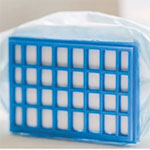 Researchers develop a reusable filter paper made from titanium dioxide nanowires that is capable of trapping and killing pathogens like the SARS-CoV-2 virus.
Researchers develop a reusable filter paper made from titanium dioxide nanowires that is capable of trapping and killing pathogens like the SARS-CoV-2 virus.
 A PES-based membrane with homogeneous sponge-like pore size membrane structure is demonstrated to improve virus filtration.
A PES-based membrane with homogeneous sponge-like pore size membrane structure is demonstrated to improve virus filtration.
 An electrostatically charged nanofiber filter that is able to filter nano-aerosols as small as 100nm. This characteristic confers the ability to filter viruses.
An electrostatically charged nanofiber filter that is able to filter nano-aerosols as small as 100nm. This characteristic confers the ability to filter viruses.
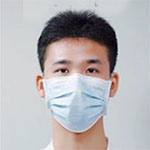 The charge-laden melt-blown filtration layer includes a piezoelectric polymer. Charges are initiated by mechanical and acoustic energy during daily speaking.
The charge-laden melt-blown filtration layer includes a piezoelectric polymer. Charges are initiated by mechanical and acoustic energy during daily speaking.
 Researchers developed a a highly breathable and thermal comfort filter medium consisting of electret polyethersulfone / barium titanate nanofibrous membrane (PES/BaTiO3 NFM) integrated on a nonwoven polypropylene substrate.
Researchers developed a a highly breathable and thermal comfort filter medium consisting of electret polyethersulfone / barium titanate nanofibrous membrane (PES/BaTiO3 NFM) integrated on a nonwoven polypropylene substrate.
 The proposed mask is designed with multilayer filters, in which the inner three layers act as a triboelectric filter and the outer one as an electrocution layer.
The proposed mask is designed with multilayer filters, in which the inner three layers act as a triboelectric filter and the outer one as an electrocution layer.
 This review opens up a new horizon in possible textile applications especially, an active layer of bioactive agent (Curcumin and Moringa) loaded nanofibrous fabrics-based facemasks for day to day life.
This review opens up a new horizon in possible textile applications especially, an active layer of bioactive agent (Curcumin and Moringa) loaded nanofibrous fabrics-based facemasks for day to day life.
 A biodegradable, moisture-resistant, highly breathable, and high-performance fibrous mask filter with two biodegradable microfiber and nanofiber mats that are integrated into a Janus membrane filter and then coated by cationically charged chitosan nanowhiskers.
A biodegradable, moisture-resistant, highly breathable, and high-performance fibrous mask filter with two biodegradable microfiber and nanofiber mats that are integrated into a Janus membrane filter and then coated by cationically charged chitosan nanowhiskers.
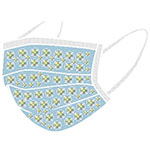 The mask's ZIF-8-based coating exhibited high antimicrobial properties against S. Aureus and high antiviral properties against SARS-CoV-2's surrogates.
The mask's ZIF-8-based coating exhibited high antimicrobial properties against S. Aureus and high antiviral properties against SARS-CoV-2's surrogates.
 This paper reports that copper oxide nanoclusters grafted with titanium dioxide (CuxO/TiO2) inactivated the SARS-CoV-2 virus.
This paper reports that copper oxide nanoclusters grafted with titanium dioxide (CuxO/TiO2) inactivated the SARS-CoV-2 virus.
 The mask was fabricated by the electrospinning of PVA, PEO, and cellulose nanofiber, followed by esterification and the deposition of a nitrogen-doped TiO2 and TiO2 mixture.
The mask was fabricated by the electrospinning of PVA, PEO, and cellulose nanofiber, followed by esterification and the deposition of a nitrogen-doped TiO2 and TiO2 mixture.
 The MOF/fiber composite exhibits rapid activity against SARS-CoV-2 and both gram-negative bacteria (E. coli) and gram-positive bacteria (S. aureus).
The MOF/fiber composite exhibits rapid activity against SARS-CoV-2 and both gram-negative bacteria (E. coli) and gram-positive bacteria (S. aureus).
 The mask contains a system of nanofiber on nanoporous polyethylene (fiber/nanoPE) where the nanofibers with strong particulate matter (PM) adhesion ensure high PM capture efficiency (99.6% for PM2.5) with low pressure drop and the nanoPE substrate with high-infrared (IR) transparency (92.1%, weighted based on human body radiation) results in effective radiative cooling.
The mask contains a system of nanofiber on nanoporous polyethylene (fiber/nanoPE) where the nanofibers with strong particulate matter (PM) adhesion ensure high PM capture efficiency (99.6% for PM2.5) with low pressure drop and the nanoPE substrate with high-infrared (IR) transparency (92.1%, weighted based on human body radiation) results in effective radiative cooling.
 This study investigates airflow resistance of carbon nanotube-based filtration material and compares its bioaerosol filtering performances with commercially available facepiece respirators.
This study investigates airflow resistance of carbon nanotube-based filtration material and compares its bioaerosol filtering performances with commercially available facepiece respirators.
 A novel low-cost surgical mask where Cu2-xS nanocrystals are in-situ grown on a spun-bonded nonwoven fabrics layer from surgical masks as the substrate. The mask is suitable for photothermal sterilization in a short time (6 minutes).
A novel low-cost surgical mask where Cu2-xS nanocrystals are in-situ grown on a spun-bonded nonwoven fabrics layer from surgical masks as the substrate. The mask is suitable for photothermal sterilization in a short time (6 minutes).
 A novel charged PVDF nanofiber filter technology to effectively capture the fast-spreading, deadly airborne coronavirus with the target aerosol size set at 100 nm (nano-aerosol).
A novel charged PVDF nanofiber filter technology to effectively capture the fast-spreading, deadly airborne coronavirus with the target aerosol size set at 100 nm (nano-aerosol).
 Researchers report the development of macroscopic carbon nanotube air filters synthesized using ultra-thin carbon nanotube electrically conductive membranes, mechanically supported by a porous polyester backing.
Researchers report the development of macroscopic carbon nanotube air filters synthesized using ultra-thin carbon nanotube electrically conductive membranes, mechanically supported by a porous polyester backing.
 A reusable, self-sustaining, highly effective, and humidity-resistant air filtration membrane with excellent particle-removal efficiency, based on highly controllable and stable piezoelectric electrospun poly (l-lactic acid) (PLLA) nanofibers.
A reusable, self-sustaining, highly effective, and humidity-resistant air filtration membrane with excellent particle-removal efficiency, based on highly controllable and stable piezoelectric electrospun poly (l-lactic acid) (PLLA) nanofibers.
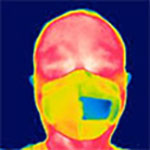 Researchers have developed a multifunctional wireless smart mask, capable of identifying mask-wearing conditions and monitoring the frequency and pattern of coughing.
Researchers have developed a multifunctional wireless smart mask, capable of identifying mask-wearing conditions and monitoring the frequency and pattern of coughing.
 This work presents a novel nanocomposite synthesis approach, which allows zinc oxide nanoparticles to be grown within textile and face mask materials, including melt-blown polypropylene and nylon-cotton.
This work presents a novel nanocomposite synthesis approach, which allows zinc oxide nanoparticles to be grown within textile and face mask materials, including melt-blown polypropylene and nylon-cotton.
